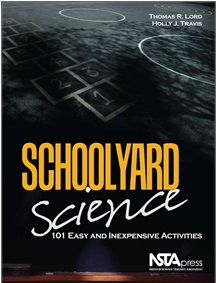How to Turn Your Schoolyard into a Year-Round Scientific Classroom
By Carole Hayward
Posted on 2014-06-11
 It would take mere seconds for any one of us to explain how technology has improved our everyday lives. Yet there are some downsides to all these “life upgrades.” How many of us spend more time exploring our new smartphone app or game than we do the great outdoors? A more sedentary lifestyle is certainly associated with increased health concerns, especially for children, who, research clearly shows, do not play outside as much as they used to/as much as they need to.
It would take mere seconds for any one of us to explain how technology has improved our everyday lives. Yet there are some downsides to all these “life upgrades.” How many of us spend more time exploring our new smartphone app or game than we do the great outdoors? A more sedentary lifestyle is certainly associated with increased health concerns, especially for children, who, research clearly shows, do not play outside as much as they used to/as much as they need to.
Teachers have the power to help reverse many negative health trends occurring with their students by taking their lessons outside of their bricks and mortar buildings. But two obstacles usually prevent this from happening: dwindling funds and/or inadequate resources.
In Schoolyard Science: 101 Easy and Inexpensive Ideas, authors Thomas R. Lord and Holly J. Travis have created more than 100 activities for pre-K through grade 8 teachers to use the external environment immediately outside the walls of their school buildings for their science lessons.
Each inquiry-based, student-directed activity is noncompetitive and was piloted across classrooms, in youth camp activities, or as part of science education classes in teacher preparation programs. All are specifically intended for teachers who have limited backgrounds in scientific nomenclature. The book’s 11 chapters allow teachers to create teamwork-based outdoor scientific activities and experiences that help students develop their critical thinking and collaborative skills. Read a sample chapter: Schoolyard Gardens and Nature Walks.
According to Lord and Travis, “The intent of this book is for students to develop observation skills and an appreciation for the environment, and for teachers to feel comfortable using natural resources available in the schoolyard.” The authors add that all the activities in the book were developed around “easily obtained and inexpensive materials” and that their most important objective in writing this book was to “keep teachers and students actively learning and spending time outside in the natural world.”
Would you like to incorporate a nature walk into your lesson, plant a garden on school grounds, launch a composting program, or build your own watershed? Maybe you’d like your students to create arts with natural materials, monitor weather in the schoolyard, or make a solar oven. If so, this book is for you and your students.
Happy exploring all the wonders of the scientific world that are occurring right on your schoolyard!
This book is also available as an e-book. Additional resources from NSTA Press on outdoor science include Outdoor Science: A Practical Guide; Inside-Out: Environmental Science in the Classroom and the Field, Grades 3–5; Bringing Outdoor Science In: Thrifty Classroom Lessons; Buzz Into Action: The Insect Curriculum for Grades K–4; and Hop Into Action: The Amphibian Curriculum for Grades K–4.
Disclaimer: The views expressed in this blog post are those of the author(s) and do not necessarily reflect the official position of the National Science Teaching Association (NSTA).


